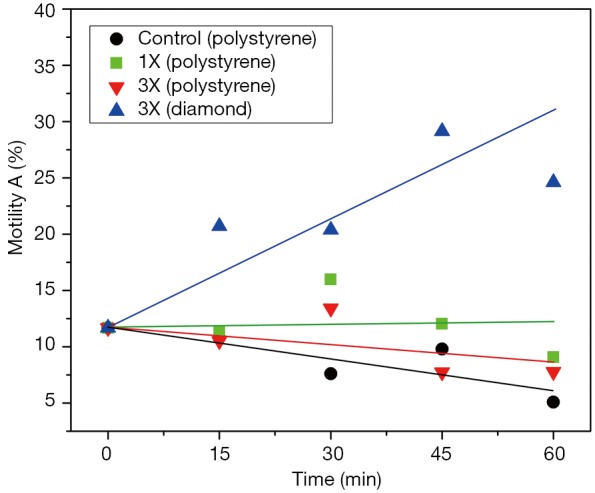Figure 2.

Measurements of motility (A) were carried out at different points in time. The black line (--●--) represents the control group (polystyrene). The green line (--■--) stands for sperm cells irradiated with 670 nm LED light at a dose (1X =6.4 kJ/m2) known to boost mitochondrial ATP. As can be seen the cells respond with a clear increase in motility. Very interesting are the results for irradiation at a triple dose (3X =19.2 kJ/m2) known to induce an increase in intracellular ROS, manifesting itself as a decrease in sperm motility. Indeed, the red line (--▼--) reflects such a behaviour for the cells irradiated in polystyrene Petri dishes. Surprisingly, even at detrimental light doses (3X) the cells in the diamond Petri dish (--▲--) respond with an enormous increase in motility. To gain insight into the root cause of the effect, sperm motilities were measured in diamond Petri dishes without LED irradiation. Here too we observed a giant increase in motility, comparable to the samples irradiated in the diamond Petri dish. To explain the giant boost in motility, we are led to assume that the nanodiamond surface is not only virtually ROS free but possesses even the capacity to neutralize effects of oxidative stress (ROS) as can be concluded from comparison with the relatively low sperm motility on polystyrene [red line (--▼--)] where the LED treatment had a detrimental impact on sperm motility. The inescapable conclusion is that nanodiamond acts as a scavenger/neutralizer for ROS, in particular for ROS originating from the sperm cells themselves. Additional experiments and computer simulations are now necessary to understand the effect of the nanodiamond on interfacial ROS and to assess the implication of the nanoscopic water layer at the diamond/cell interface in the ROS scavenging/neutralizing process. Measurement points represent the average from five samples with three counts per sample, and are statistically significant. Motility measurements were performed in a Makler chamber using a conventional optical microscope. The device employed to irradiate the sperm cells was a WARP 10 with an intensity of 728 W/m2. It was previously used by us in skin rejuvenation (20). ATP, adenosine triphosphate; ROS, reactive oxygen species.
